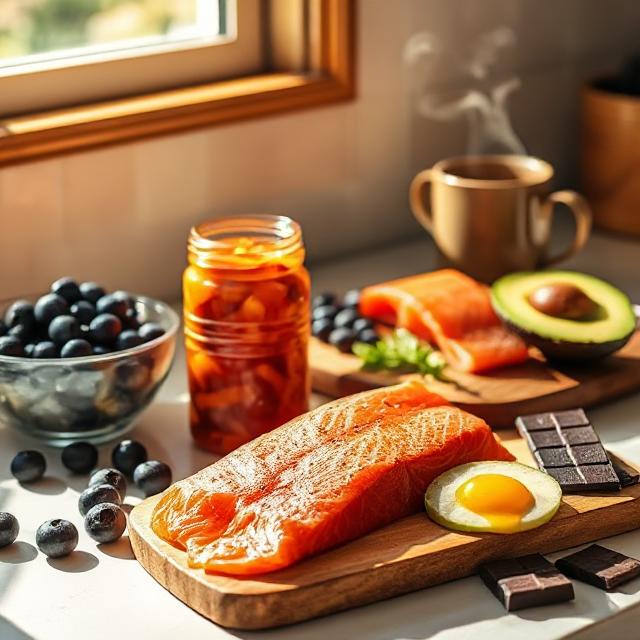
Table of Contents
Gut-Brain Axis: 5 Foods That Support Mental Clarity
The gut and brain are in constant communication, forming what science calls the gut-brain axis—a two-way information superhighway that links digestion, emotion, cognition, and mood. Far from being independent systems, your gut microbiome and central nervous system work as a synchronized unit, shaping everything from focus and memory to resilience and clarity.
Emerging research shows that by eating the right foods, we can fine-tune this communication system—boosting neurotransmitter production, reducing inflammation, and enhancing mental performance. In this article, we’ll explore 5 of the most impactful foods for supporting the gut-brain axis and why they belong in your daily protocol.
🧠 Understanding the Gut-Brain Axis
The gut-brain axis is a bidirectional network composed of:
- The enteric nervous system (often called the “second brain”)
- The vagus nerve, acting as a communication bridge
- The microbiota, which produce neurotransmitters like GABA and serotonin
- The immune system, modulating inflammatory responses
- The hypothalamic-pituitary-adrenal (HPA) axis, which governs stress signaling
When the gut is out of balance—due to inflammation, dysbiosis, or leaky gut—this entire network is disrupted, leading to symptoms like brain fog, anxiety, low focus, and mood swings.
Nutrition is the most direct, daily way we influence this axis. Here’s how to use food to restore clarity, reduce systemic stress, and fuel cognitive flow.
🥬 1. Fermented Foods: Probiotic Powerhouses
Examples: kimchi, sauerkraut, kefir, yogurt, miso
Fermented foods are rich in probiotics—live bacterial cultures that help restore microbial diversity in the gut. These beneficial bacteria:
- Produce short-chain fatty acids (SCFAs) like butyrate, which calm brain inflammation
- Stimulate serotonin and GABA production
- Improve gut lining integrity
- Support vagal tone, enhancing gut-brain signaling
Why it helps: A robust microbiome sends “calm” signals to the brain and sharpens neurotransmission.
Pro Tip: Rotate different fermented foods weekly to introduce new bacterial strains and prevent immune intolerance.
🫐 2. Polyphenol-Rich Berries
Examples: blueberries, blackberries, raspberries, elderberries
Berries are bursting with polyphenols, plant compounds known for their antioxidant and anti-inflammatory properties. These bioactives:
- Feed beneficial gut bacteria (prebiotic effect)
- Reduce neuroinflammation in the brain
- Improve blood-brain barrier function
- Enhance memory and executive function
Why it helps: Polyphenols act like fertilizer for your brain’s operating system, clearing away mental fog and stabilizing mood.
Pro Tip: Pair berries with healthy fats (like Greek yogurt or chia pudding) to enhance polyphenol absorption.
🥑 3. Omega-3 Fats from Whole Foods
Examples: wild salmon, sardines, flaxseed, chia seeds, walnuts
Omega-3 fatty acids—particularly EPA and DHA—are essential for neural membrane function. They’re also crucial in maintaining microbial balance and reducing gut inflammation.
- EPA reduces pro-inflammatory cytokines
- DHA strengthens synaptic connections in the brain
- Omega-3s modulate gut immunity and reduce leaky gut symptoms
Why it helps: This fat feeds both your neurons and your gut lining—supporting sustained focus and emotional regulation.
Pro Tip: Aim for 2–3 servings of omega-3-rich foods per week or supplement with high-quality fish oil if needed.
🍠 4. Resistant Starches and Prebiotic Fibers
Examples: green bananas, cooked and cooled potatoes, oats, Jerusalem artichoke, onions, garlic
These foods resist digestion in the small intestine, reaching the colon where they are fermented by gut microbes into SCFAs. SCFAs like butyrate:
- Maintain tight junctions in the gut wall
- Fuel colon cells (colonocytes)
- Support serotonin synthesis in the gut lining
- Reduce systemic and neural inflammation
Why it helps: Prebiotics create the metabolic fuel for a thriving microbiome and clear-thinking brain.
Pro Tip: Start small—too much resistant starch too quickly can cause bloating. Build up gradually.
🍫 5. Dark Chocolate (80%+ Cocoa)
Examples: raw cacao, dark chocolate (80% or higher), cacao nibs
Raw cocoa is a unique brain food that combines polyphenols, magnesium, and theobromine—a mild stimulant that enhances blood flow to the brain. Its gut effects are also profound:
- Promotes growth of Lactobacillus and Bifidobacterium strains
- Enhances vagus nerve activation
- Boosts dopamine levels and mood stability
Why it helps: Dark chocolate creates a double effect—feeding the gut microbiome while gently stimulating cerebral circulation.
Pro Tip: Use cacao in smoothies, or enjoy a square post-meal. Avoid milk chocolate, which blunts its benefits.
🔄 Bonus: Build a Gut-Brain Plate
To activate your gut-brain axis daily, combine these food types into meals. Here’s a sample combo:
- Breakfast: Overnight oats with kefir, blueberries, and chia seeds
- Lunch: Salmon salad with sauerkraut and garlic vinaigrette
- Snack: A few walnuts and 1 square of 85% dark chocolate
- Dinner: Roasted sweet potato with sautéed onions and olive oil
This keeps your microbiota well-fed, inflammation down, and brain signals sharp.
🧬 Final Thoughts: From Gut Fuel to Mental Fire
The gut-brain axis is no longer theoretical—it’s physiological, measurable, and modifiable. The foods you choose can either fan the flames of fog or light the fire of focused thinking.
By including these 5 foods regularly, you help:
- Reduce neural inflammation
- Strengthen gut lining integrity
- Elevate neurotransmitter balance
- Promote emotional and cognitive resilience
In a distracted world, a clear mind starts with a healthy gut.